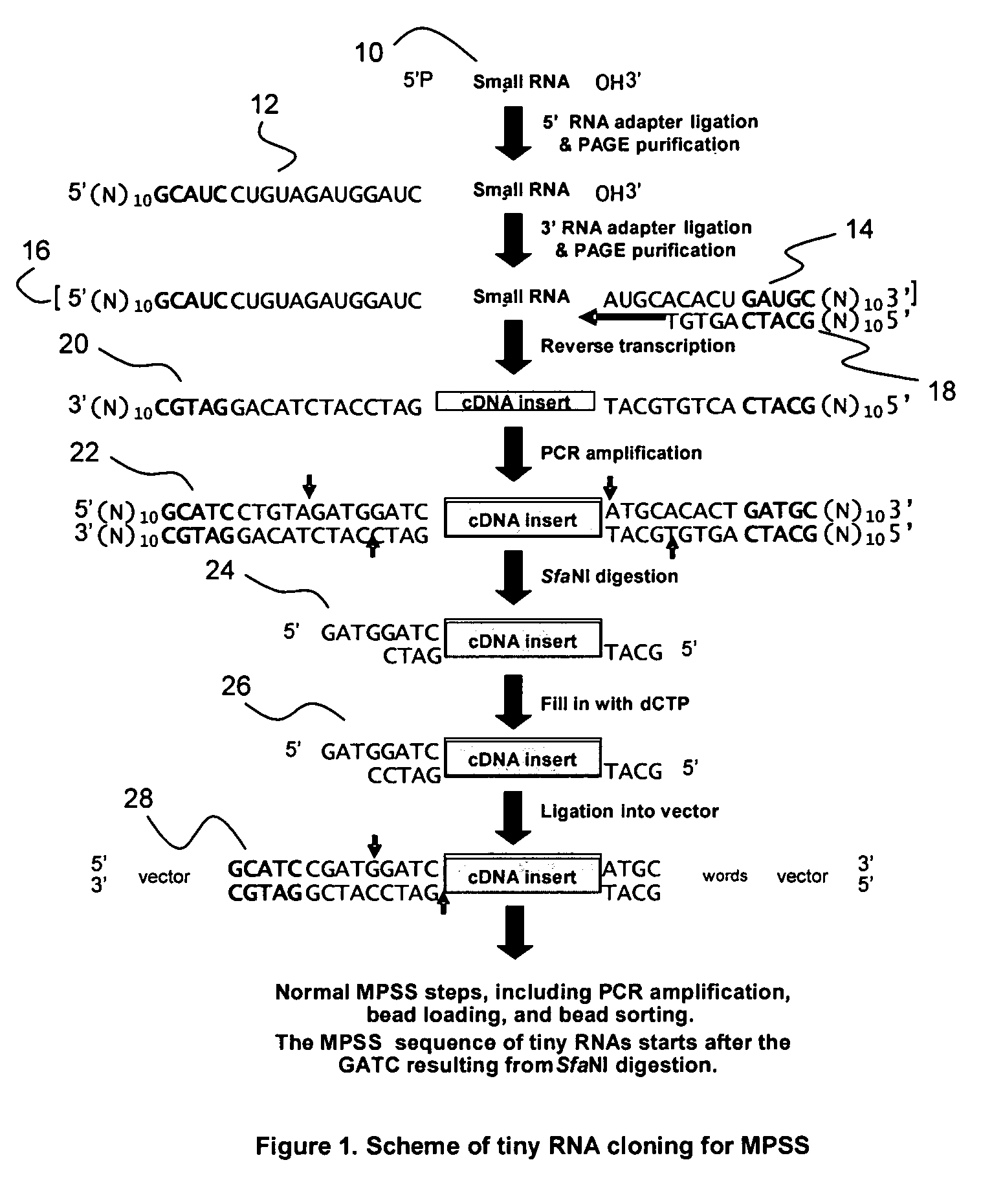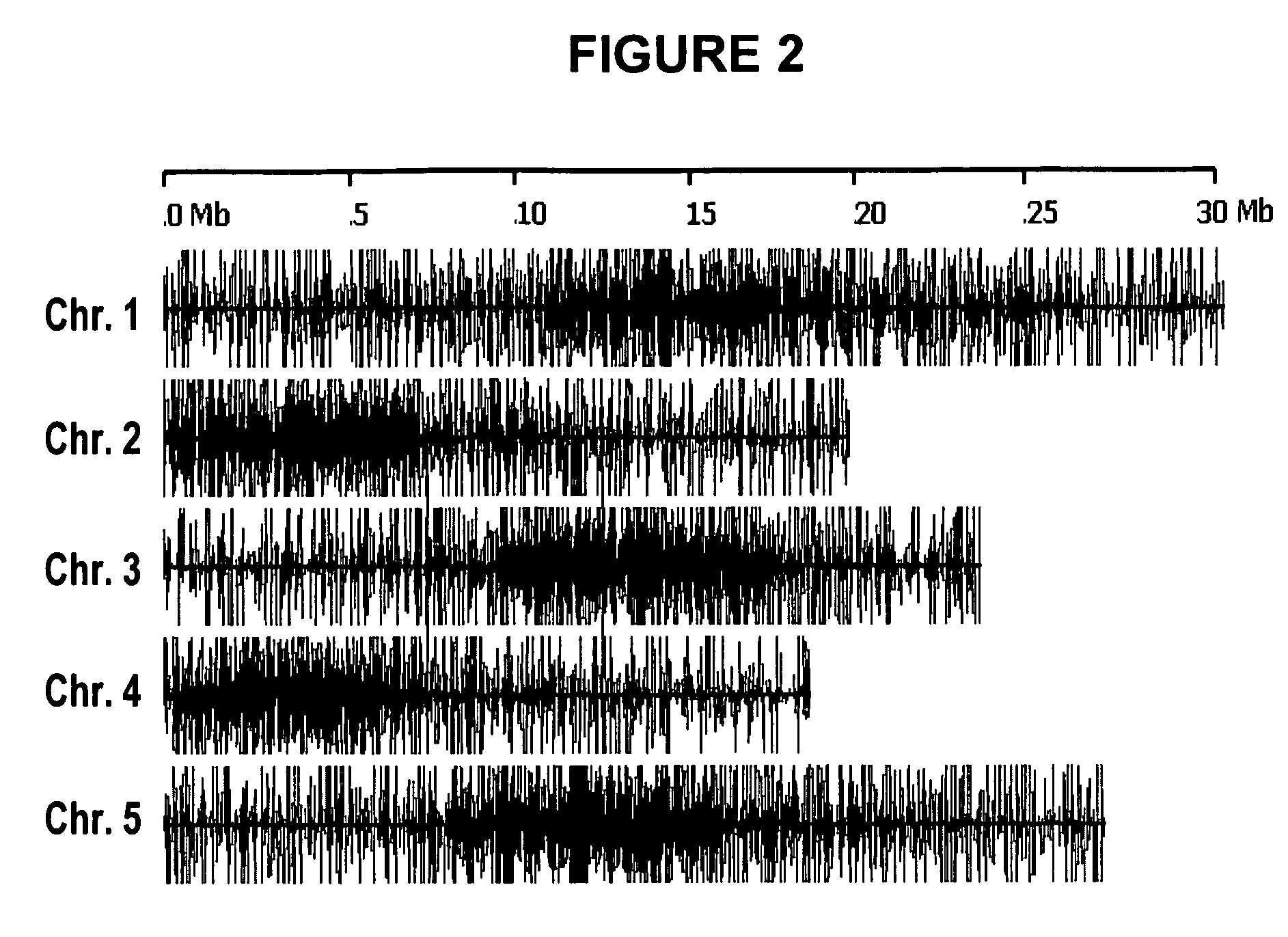Method for identification and quantification of short or small RNA molecules
- Summary
- Abstract
- Description
- Claims
- Application Information
AI Technical Summary
Benefits of technology
Problems solved by technology
Method used
Image
Examples
example 1
Low Molecular Weight (LMW) RNA isolation
[0057] Isolation of small or tiny RNA molecules was performed according to the following procedure: [0058] 1. Plant material from Arabidopsis thaliana (thale cress) was harvested and frozen in liquid nitrogen and ground to a fine powder. [0059] 2. Total RNA was isolated using TRIZOL (Invitrogen) reagent according to product protocol. [0060] 3. The total RNA (at least 500 ug) was dissolved in DEPC treated water. [0061] 4. mRNA and rRNA (high molecular weight RNAs) were precipitated in a solution of 10% PEG (MW=8000) (final concentration) and 0.5 M NaCl (final concentration). [0062] 5. The precipitating solution of RNA was mixed well and cooled in ice for 30 minutes. [0063] 6. The solution was centrifuged at max speed (˜11,000 g) for 10 minutes. The pellet contains the HMW RNAs and the supernatant contains the low molecular weight RNA molecules. [0064] 7. The supernatant was transferred to a microcentrifuge tube and 2.5 volumes of 100% EtOH was...
example 2
Purification of RNA 17-27mers from LMW RNA
[0068] 1. Glass and spacers were prepared for pouring an polyacrylamide / urea gel.
[0069] 2. A 15% polyacrylamide / urea gel was prepared. The components (see table below) were mixed and the solution was warmed to 37C in order to dissolve the urea. The solution was filtered through a nitrocellulose filter and cooled to room temperature.
ReagentsUrea31.5 gAcrylamide stock29.5 ml5 × TBE 15 mlWater 8 ml
[0070] 3. 0.45 ml of a freshly prepared solution of 10% ammonium persulfate was added to the acrylamide solution and mixed well, using caution to avoid aeration of the solution.
[0071] 4. 35 ul of TEMED was added to the above mixture, and the solution was mixed by gentle swirling. The solution was drawn into the barrel of a 50 ml syringe, and any air that entered the barrel was expelled. The nozzle of the syringe was introduced into the space between the two glass plates, and the space was filled almost to the top. The glass plates were place ag...
example 3
5′ Adaptor Ligation and Purification
[0086] 1. Initiate a 5′ adaptor ligation reaction with the following components: [0087] a. 5 μl 17-27 nt RNAs [0088] b. 2 μl 200 μM 5′ RNA adaptor [0089] c. 1 μl 10× Ligation Buffer [0090] d. 2 μl T4 RNA ligase (Ambion, 5 u / μl)
[0091] 2. Incubate at room temperature for 4-6 hours.
[0092] 3. Stop reaction with 10 μl 2× Loading Dye.
[0093] 4. Prepare a 10% denaturing polyacylamide gel. Prerun, then load into 2 lanes. Run gel until good separation of BB and XC.
[0094] 5. Slice corresponding gel band (46-56 nt), put into 2 ml tube and crush.
[0095] 6. Add two volumes of RNA elution buffer (0.3 M NaCl).
[0096] 7. Elute overnight at RT with shaking.
[0097] 8. Filter through glass wool or Millex-HA 0.45 μm filter unit (optional).
[0098] 9. Extract with chloroform once.
[0099] 10. Precipitate with 2.5 volumes of 100% EtOH with 2 μl glycogen (Ambion, 5 mg / ml). Cool at −80° C. for 30 minutes.
[0100] 11. Spin at max speed (approximately 11,000 g) at 4° C. f...
PUM
| Property | Measurement | Unit |
|---|---|---|
| Volume | aaaaa | aaaaa |
| Volume | aaaaa | aaaaa |
| Volume | aaaaa | aaaaa |
Abstract
Description
Claims
Application Information
 Login to View More
Login to View More - R&D
- Intellectual Property
- Life Sciences
- Materials
- Tech Scout
- Unparalleled Data Quality
- Higher Quality Content
- 60% Fewer Hallucinations
Browse by: Latest US Patents, China's latest patents, Technical Efficacy Thesaurus, Application Domain, Technology Topic, Popular Technical Reports.
© 2025 PatSnap. All rights reserved.Legal|Privacy policy|Modern Slavery Act Transparency Statement|Sitemap|About US| Contact US: help@patsnap.com


